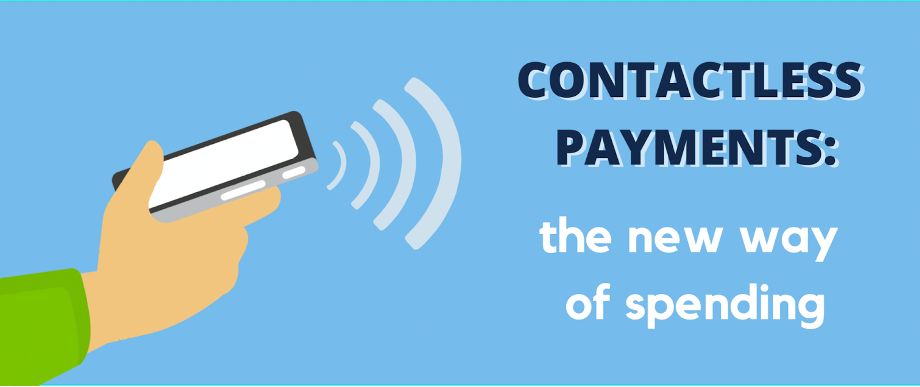Author: Andrew Wong, Graphics: Nina Tagliabue
The BRB Bottomline
Contactless payments have been on the rise as of the main methods of payments, especially with the COVID-19 pandemic encouraging limited personal contact. This article will help define and explore the surge of contactless payments in daily life.
Contactless Payments are a method of payment that requires a single tap from a credit/debit card or smartphone that is configured with a digital wallet. They’ve been on the rise ever since their inception, statistics showing that 51% of Americans use some sort of contactless payments in their transactions.
The customer can just tap their credit/debit card or smartphone (if configured with a digital wallet) on a chip reader to complete a transaction. This intuitively seems more efficient and straightforward than a traditional transaction, where the customer has to rustle through their wallet or belongings for money and interact with the cashier. In addition, contactless payments skip the process of entering a PIN and the typical signature, further proving maximization of efficiency. With just a tap, they are just objectively faster than traditional transactions and overall require less physical contact, which can help explain why contactless methods have spiked in preference recently through the pandemic.
The Pandemic’s Effects on Consumer Habits
The pandemic originally proved to be quite detrimental to existing businesses, but they were quick to adapt. Smaller and newer businesses eventually pivoted their business model and payment options to capitalize on contactless payments, bypassing issues of sanitation and health through physical transactions. This proved to be quite beneficial as customers would become more comfortable with buying from businesses in person, which in turn helped businesses stay afloat or even thrive through the complications COVID-19 had on in-person interactions. Surveys showed that 54% of consumers said that they would choose retailers that offered contactless payment options over those that did not. VISA reported a 30% increase in tap payments. Further statistics from the same study show that younger people, especially millennials, strongly approve of this switch, further solidifying reasons for businesses to make the switch to contactless payments. This also makes sense as the younger population will be the main consumers in society for a long time.
A Quick Summary + More
- Statistics report that much of the population would rather shop at retailers with contactless payment options
- This in turn has helped businesses re-evaluate and change their business models to incorporate contactless payments to boost sales
- Issues of fraud and safety are also minimized in certain ways as there is no chance of utilizing the magnetic strip to steal credit card information, a common technological fraud concern
Personally, as a younger individual, I would say I agree with the reasons behind switching to contactless options, as it especially makes day-to-day transactions much faster and safer. I can safely say that my daily runs to the local Blaze Pizza have been much faster and more convenient as I round off my order with an easy transaction process.
**PSA I am not sponsored nor endorsed by Blaze Pizza nor fully condone their enterprise, but like good pizza is good pizza.
Security, Impulsive Spending, and Other Technological Complications in Society
As contactless payments become the prominent method of transactions, society must in turn adapt as it is still a relatively new technology. With this, one must acknowledge the intricacies and consequences that accompany the new standard of transactions, as with new standards for anything new in society. One specific issue that often comes to mind is the risk of fraud and safety, a specific downside to the proclaimed efficiency of contactless payments. If one were to lose their method of contactless payment, they would probably first worry as there aren’t many, if any, precautions tap payment methods have instituted that prevent unwanted users of payment; another individual can just as easily just tap a debit card that isn’t theirs as contactless payments do not require PIN or signatures. Ironically, the same inefficient factors of traditional payment prove to be effective security measures. Adding on to this seemingly “too” efficient method of spending comes with the risk of impulsive spending, as users have one less hurdle they have to deal with before the transaction, sometimes proving helpful (I myself resonate with) in making the consumer rethink their transactions. There are actually statistics that show how much of the younger population have spent more money over recent years, especially on things they wouldn’t normally purchase and even were shocked on how they spent their money; this could be a potential association of how over-efficiency could lead to less thought in transactional decisions.
Technological Dependence in Society
Looking from a macro perspective, if contactless payments become the norm, businesses worldwide must adapt, which could prove to be difficult, especially for those who cannot afford to instate the change. When looking at the individual and their interactions within society, one could even argue that this will lead to even less personal interaction as there is no need to converse with the seller/cashier. This further ties to the ever-increasing issue of our addiction to technology and decline in human interaction.
Take-Home Points
- Contactless Payments are up and coming with their efficiency and practice in hygiene compared to traditional methods of transactions
- Businesses must in turn react accordingly as much of the population is switching their preferences in payment options to contactless
- There are also general security issues that accompany the boosted efficiency as it incredibly easy for unwanted users to conduct stolen/fraudulent contactless payments
- As contactless payments become the prominent method of transaction, everyone ranging from consumers to sellers must adapt to this, accepting technological aspects and the unwanted factors that come along with it, as every new method has its pros and cons that people must learn to adapt to

